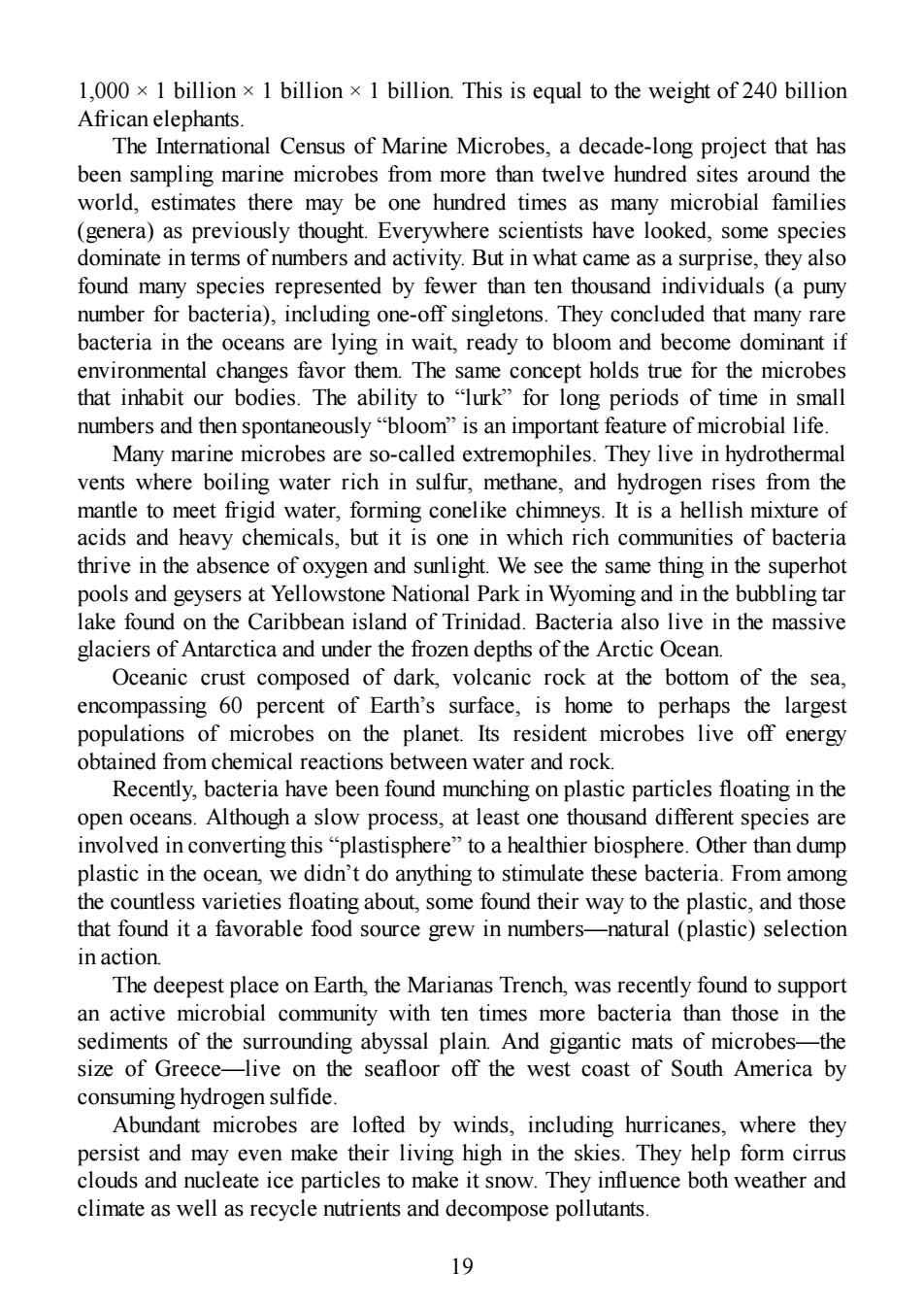正在加载图片...

1.000 x 1 billion x 1 billion x 1 billion.This is equal to the weight of 240 billion African elephants. The International Census of Marine Microbes,a decade-long project that has been sampling marine microbes from more than twelve hundred sites around the world,estimates there may be one hundred times as many microbial families (genera)as previously thought.Everywhere scientists have looked,some species dominate in terms of numbers and activity.But in what came as a surprise,they also found many species represented by fewer than ten thousand individuals (a puny number for bacteria),including one-off singletons.They concluded that many rare bacteria in the oceans are lying in wait,ready to bloom and become dominant if environmental changes favor them.The same concept holds true for the microbes that inhabit our bodies.The ability to "lurk"for long periods of time in small numbers and then spontaneously"bloom"is an important feature of microbial life. Many marine microbes are so-called extremophiles.They live in hydrothermal vents where boiling water rich in sulfur,methane,and hydrogen rises from the mantle to meet frigid water,forming conelike chimneys.It is a hellish mixture of acids and heavy chemicals,but it is one in which rich communities of bacteria thrive in the absence of oxygen and sunlight.We see the same thing in the superhot pools and geysers at Yellowstone National Park in Wyoming and in the bubbling tar lake found on the Caribbean island of Trinidad.Bacteria also live in the massive glaciers of Antarctica and under the frozen depths of the Arctic Ocean. Oceanic crust composed of dark,volcanic rock at the bottom of the sea, encompassing 60 percent of Earth's surface,is home to perhaps the largest populations of microbes on the planet.Its resident microbes live off energy obtained from chemical reactions between water and rock. Recently,bacteria have been found munching on plastic particles floating in the open oceans.Although a slow process,at least one thousand different species are involved in converting this "plastisphere"to a healthier biosphere.Other than dump plastic in the ocean,we didn't do anything to stimulate these bacteria.From among the countless varieties floating about,some found their way to the plastic,and those that found it a favorable food source grew in numbers-natural (plastic)selection in action The deepest place on Earth,the Marianas Trench,was recently found to support an active microbial community with ten times more bacteria than those in the sediments of the surrounding abyssal plain.And gigantic mats of microbes-the size of Greece-live on the seafloor off the west coast of South America by consuming hydrogen sulfide. Abundant microbes are lofted by winds,including hurricanes,where they persist and may even make their living high in the skies.They help form cirrus clouds and nucleate ice particles to make it snow.They influence both weather and climate as well as recycle nutrients and decompose pollutants. 19 1,000 × 1 billion × 1 billion × 1 billion. This is equal to the weight of 240 billion African elephants. The International Census of Marine Microbes, a decade-long project that has been sampling marine microbes from more than twelve hundred sites around the world, estimates there may be one hundred times as many microbial families (genera) as previously thought. Everywhere scientists have looked, some species dominate in terms of numbers and activity. But in what came as a surprise, they also found many species represented by fewer than ten thousand individuals (a puny number for bacteria), including one-off singletons. They concluded that many rare bacteria in the oceans are lying in wait, ready to bloom and become dominant if environmental changes favor them. The same concept holds true for the microbes that inhabit our bodies. The ability to “lurk” for long periods of time in small numbers and then spontaneously “bloom” is an important feature of microbial life. Many marine microbes are so-called extremophiles. They live in hydrothermal vents where boiling water rich in sulfur, methane, and hydrogen rises from the mantle to meet frigid water, forming conelike chimneys. It is a hellish mixture of acids and heavy chemicals, but it is one in which rich communities of bacteria thrive in the absence of oxygen and sunlight. We see the same thing in the superhot pools and geysers at Yellowstone National Park in Wyoming and in the bubbling tar lake found on the Caribbean island of Trinidad. Bacteria also live in the massive glaciers of Antarctica and under the frozen depths of the Arctic Ocean. Oceanic crust composed of dark, volcanic rock at the bottom of the sea, encompassing 60 percent of Earth’s surface, is home to perhaps the largest populations of microbes on the planet. Its resident microbes live off energy obtained from chemical reactions between water and rock. Recently, bacteria have been found munching on plastic particles floating in the open oceans. Although a slow process, at least one thousand different species are involved in converting this “plastisphere” to a healthier biosphere. Other than dump plastic in the ocean, we didn’t do anything to stimulate these bacteria. From among the countless varieties floating about, some found their way to the plastic, and those that found it a favorable food source grew in numbers—natural (plastic) selection in action. The deepest place on Earth, the Marianas Trench, was recently found to support an active microbial community with ten times more bacteria than those in the sediments of the surrounding abyssal plain. And gigantic mats of microbes—the size of Greece—live on the seafloor off the west coast of South America by consuming hydrogen sulfide. Abundant microbes are lofted by winds, including hurricanes, where they persist and may even make their living high in the skies. They help form cirrus clouds and nucleate ice particles to make it snow. They influence both weather and climate as well as recycle nutrients and decompose pollutants. 19